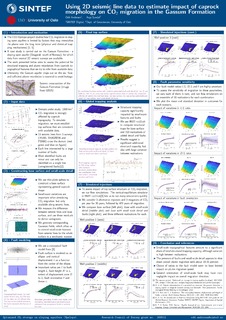| dc.description.abstract | The Gassum Formation on the Norwegian Continental Shelf serves as the principal case study for the CO2-Upslope project. The top surface of this formation is gently sloping, and characterized by a number of macro-scale structural traps, a few large faults, a large number of small faults, and small-scale depth variations that can be inferred and extrapolated from the seismic data. In the study presented in this paper, we estimate the amount of macro- and sub-scale trapping potential of the formation based on interpreted 2D seismic lines and identified faults. The seismic lines provide the depth of the caprock at each point along straight lateral paths. In the available data, a few dozen such lines cross the study area at various angles. A number of medium and large faults could be explicitly identified and mapped, as they correlate between several of these lines. In addition, hundreds of small-scale faults are only visible as discontinuities along individual lines. The extent and shape of these small faults between the seismic sections cannot be explicitly known from the data. In order to investigate trapping potential, we start out by constructing multiple realizations of the top surface, constructed to be faithful to both large-scale topography and small-scale statistical properties. We use a tensor spline surface approximation to represent the surface trend, with added stochastic small-scale variations consistent with the statistical properties of the line data. Moreover, we include a distribution small-scale faults that are only visible as discontinuities in the seismic lines by adding assumptions on their general orientations and lengths. At the timescales associated with long-term CO2 plume migration, it can generally be assumed that vertical equilibrium has been reached and that the CO2 slowly flows as a thin wedge right under the top surface, driven by gravity forces. Based on this assumption, we apply spill-point analysis and upscaling techniques on our sets of top surface realizations to explore the possible range of values for total structural trapping and plume retardation potential, and how they depend on the assumptions made. We also study the impact of the placement of the injection site, and how much of the total structural storage potential can be actually realized based on the position of the site and the injection strategy. | nb_NO |
